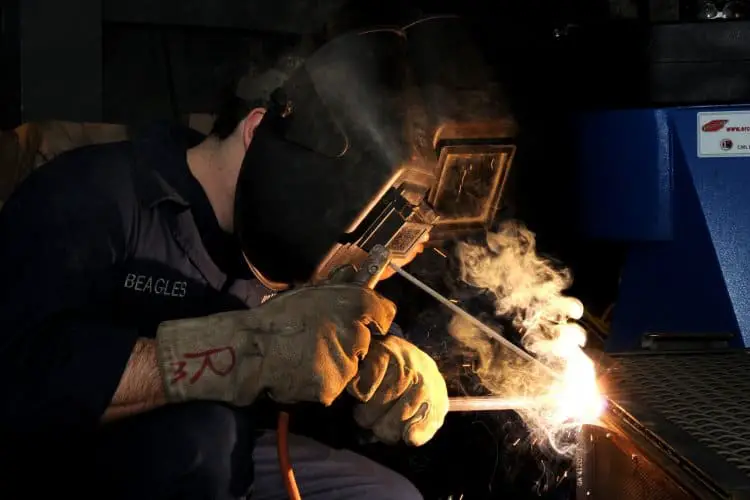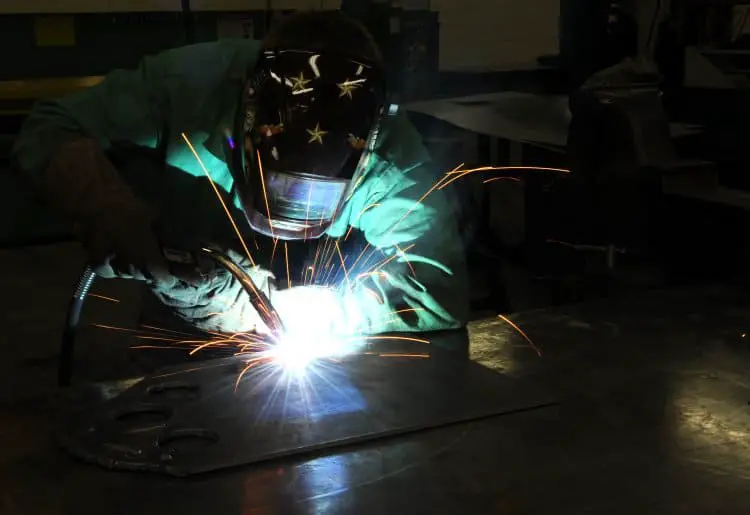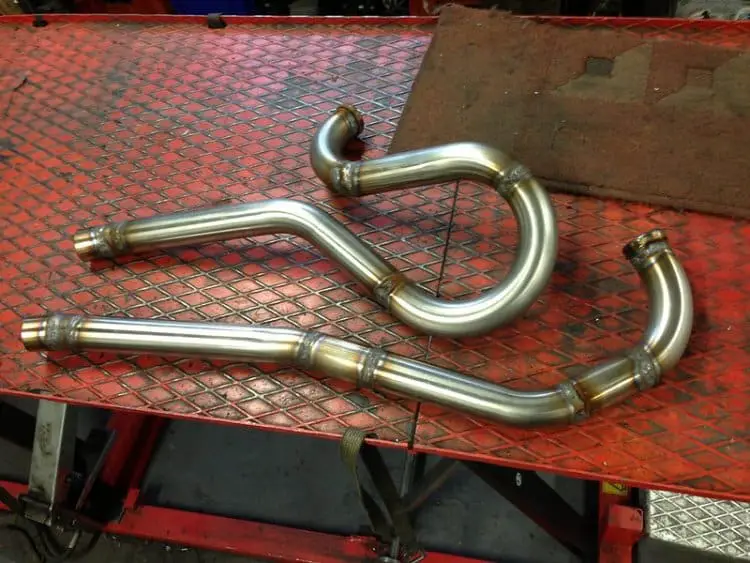This post contains affiliate links to products, services, or education. We may receive a commission for purchases made through links.
Whenever welding, it is essential to know about the potential dangers, including the fumes released at different stages of the welding process. The toxic fumes are a byproduct of all the different metals, chemicals, gases mixing. Therefore, it is vital to know about the toxicity of welding fumes to prevent being poisoned by them.
Are welding fumes toxic? The fumes produced during welding are very toxic. They can cause anything from a mild headache to death. You can protect yourself from the fumes by using a respirator that filters the air and by ensuring there is enough ventilation to disperse the fumes adequately.

There are many different types of welding, and each of them produces different levels of toxic fumes. Inhalation is the most common way that you can ingest the fumes. However, there are many ways to protect yourself.
Read on to learn more about the toxic fumes that result from welding and how to keep yourself safe.
Are MIG Welding Fumes Harmful?

MIG welding stands for metal inert gas welding. It is a welding process in which an inert gas is used to shield the metals from contamination.
The gas also prevents most of the usual toxic gases from being released, which makes it a safer method of welding.
However, that does not mean you should not use any protection while doing MIG welding (check out our recommended gear here).
Though MIG welding is one of the safer methods of welding, there is still some toxic gas that is released.
Most of this is carbon or whatever metal you are welding with, and inhaling too much can cause neurological issues.
The best form of protection would be to wear a respirator, although a thick mask would also work in a pinch.
Where Does the Toxic Gas Come From?
The toxic and dangerous gases that are a byproduct of welding come from different places.
During the welding process, gases and fumes are released as byproducts of fuels, decomposition, or the thermal breakdown of coatings.
So, there are a few different times within the welding process that toxic fumes are released, such as:
- Fuels: The fuels used for welding are most often acetylene, propane, and butane. These can be toxic either when inhaled directly or when they are mixed with other gases. The more concentrated the levels of the fuel are, the more dangerous it is to inhale it. Additionally, the more time you spend around these fumes, the more likely you are to be affected.
- Decomposition: When fumes are decomposed while welding, carbon dioxide is produced in high quantities. When the carbon dioxide that is produced is broken down, carbon monoxide is produced. Inhalation of too much carbon monoxide can lead to carbon monoxide poisoning, which is extremely lethal. Carbon monoxide is especially dangerous because it is odorless, so you should have a CO monitor in your workspace.
Ozone, nitrogen, and hydrogen chlorine are also produced as byproducts of the decomposition process.
All of these gases are very toxic and dangerous.
They can cause severe poisoning or even death in many cases. Wearing a respirator helps keep you safe from inhalation poisoning and death by toxic fumes.
- Thermal breakdown of coatings: During the welding process, many coatings and paints are broken down. During this decomposition, carbon dioxide, carbon monoxide, and hydrogen chloride are produced. These fumes are hazardous and lethal.
- Heated metal: When welding, there is an abundance of heat being used on metals and alloys. This heat can cause the metal to break down into fumes that are released into the air. These fumes can cause fevers, headaches, nausea, and if you inhale enough, it can even lead to lung diseases.
The toxic gases that are a result of welding come from many different sources and parts of the welding process.
Therefore, it is essential to use some kind of respirator at all times when welding. The longer you are exposed to toxic fumes, the more likely you are to suffer permanent damage.
Is Welding Smell Toxic?
When toxic fumes are produced from welding, one of the few ways to tell they are present is through smell.
The more pungent the smell is when welding, the more concentrated the fumes are, and the more at risk you are.
Smelling the aroma that comes from welding means inhaling the toxic fumes, which can cause considerable harm to the body.
Ventilation is key. Ventilation is an essential way to decrease your chances of being closed in with the strong fume smells while welding.
This way, the smell disperses along with the toxic fumes.
How Do You Stop Inhaling Welding Fumes?

Although all of this might make welding seem incredibly daunting, there are ways to protect yourself from the fumes.
These methods include general safety practices and specialized equipment meant to protect you from the fumes.
Some of the ways that you can protect yourself from toxic welding fumes are:
- Respirators: A respirator is a mask that filters the air you breathe or provides you with clean air (check out our recommended respirators here). The filter types work by either using a thick material or a powered air purifier. These tend to be most convenient for welders, and they do an excellent job of protecting you. There are also respirators with a remote air supply. These can be bulkier but are a foolproof method of protecting yourself from the fumes. I recommend this post on whether welders should wear respirators for more information.
- Ventilation: Though respirators are very helpful, if the toxic fumes become very concentrated, you can still be affected. By ventilating the area, the fumes disperse and never become so concentrated that a respirator would not protect you. No matter what kind of welding is being done, ventilating the area is necessary for your safety.
- Shielding gas: A shielding gas is an inert gas that can be used during the welding process to reduce contamination of the metals. It has the bonus of largely reducing the number of toxic fumes that are released. The most common type of shielding gas is carbon. Welders also use a mixture of carbon and argon often.
Besides taking these precautions, always follow the instructions for your welding.
By incorrectly using your metals, you may produce even more toxic gas. Also, be aware of your body while welding, since a headache, nausea, and lightheadedness can be signs that you have inhaled toxic fumes.
Are Stainless Steel Welding Fumes Toxic?

Stainless steel welding has become popular.
This popularity means that the dangers that come from it have also become more widespread.
Welding stainless steel is not lethal in any way, but it can cause painful and very permanent damage to a person.
When welding stainless steel, a chemical that is known as hexavalent chromium or Cr(VI) is released into the air.
It is a highly toxic chemical that can cause damage to the eyes, nose, throat, skin, and lungs. It is also carcinogenic, meaning that it has the potential to cause cancer in people who are exposed to it for extended periods.
The best way to protect yourself when welding stainless steel is to use a welding mask with an excellent air purifier.
This purifier removes the primary risks which come from inhaling the toxic fumes. Beyond that, you should keep the area ventilated and be aware of how your body is feeling. These precautions allow you to weld stainless steel safely and with minimal risks.
If you are working with stainless steel and are looking to finish it, check out this post on how to finish stainless steel after welding.
In Conclusion
No matter what or how you are welding, a certain amount of toxic fumes are released. Taking the appropriate safety precautions is of the utmost importance. Always be aware of your surroundings and body, as they alert you to signs that the fumes are present. Also, and I can’t stress this enough, ventilation is critical!
Sources:
- https://www.plymovent.com/us/blogs/welding-cutting-fume-removal/welding-stainless-steel
- https://www.safetyandhealthmagazine.com/articles/14291-welding-fume-hazards
- https://www.sciencedirect.com/topics/pharmacology-toxicology-and-pharmaceutical-science/metal-fume-fever
- https://www.aws.org/resources/detail/dealing-with-welding-fumes
- https://safe-welding.com/mig-welding-highly-hazardous-despite-lower-quantities-of-welding-fumes/
